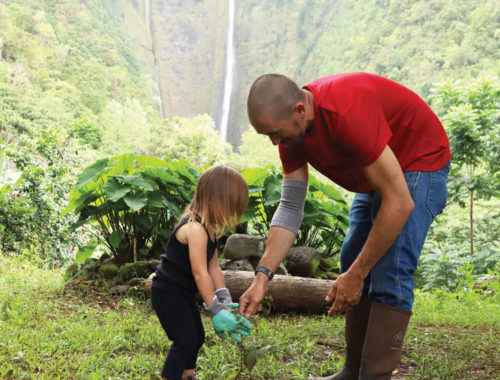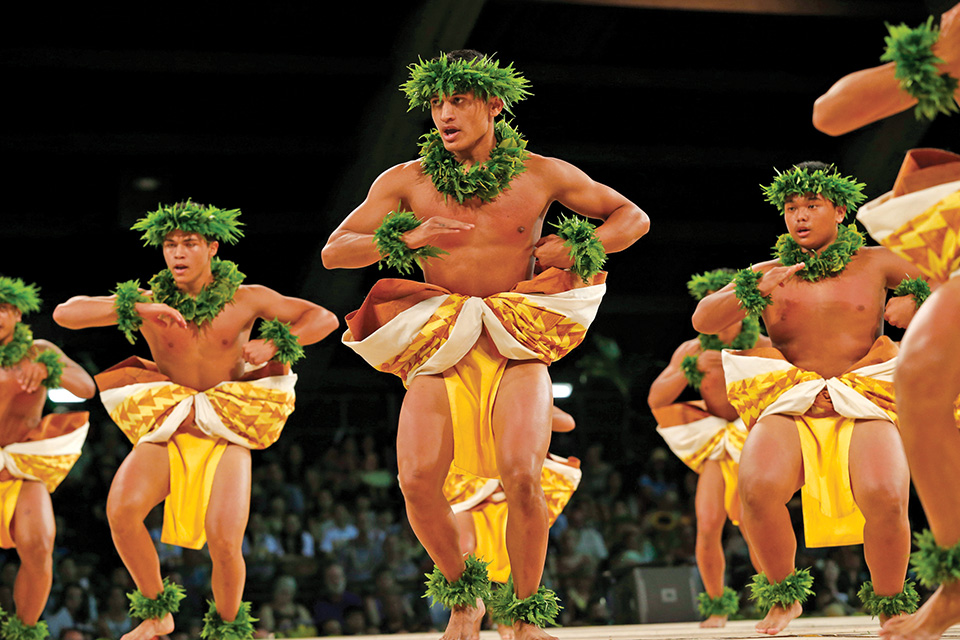Mālama Honua—Care for the Earth: The Worldwide Voyage of the Hōkūle‘a and the Hikianalia
 By Keith Nealy
By Keith Nealy
It is no surprise to the majority of people in the world that our planet is suffering from climate change; the depletion of natural resources; the degradation of our land, sea and air—conflicts that result from overconsumption and greed. As an individual, as a community, and as a nation we are left wondering who is going to do something about this? That answer may come as a surprise to many people.
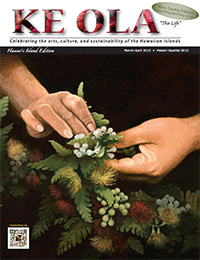
In June 2013, the Polynesian voyaging canoe, Hōkūle‘a, and its brand-new, state-of-the-art sister canoe, Hikianalia, will leave Hilo on the island of Hawai‘i and begin a four-year journey around the world, covering 46,000 miles to 21 countries with 65 currently planned landfalls. They sail for peace, for the love of our planet, and with a desire to leave the children of the world a hopeful, healthy future.
Hawai‘i Island will play a major role in these voyages as currently there are only five captains qualified to sail these canoes and three of them live here: “Shorty” Bertelmann, Chadd Cody Onihi Paishon, and Kalepa Baybayan. Shorty and Chadd have been instrumental in the Na Kalai Wa‘a (the canoe builders) Makali‘i voyaging programs on Hawai‘i island for more than 20 years. Kalepa Baybayan is the voyaging captain and cultural advisor at ‘Imiloa Astronomy center in Hilo.
More than 500 crew members will be needed to sail all the legs of the voyage. Many of them from Hawai‘i Island are in training now.

In 1976, the Hōkūle‘a made its initial historic voyage from Hawai‘i to Tahiti guided by master navigator Mau Pialug from Satawal, Micronesia. As one of the last living navigators of the ancient art of wayfinding—finding land without the use of charts or instruments—Mau was concerned about passing on his knowledge, so he agreed to teach what he knew to Nainoa Thompson of O‘ahu and Shorty Bertelmann of Hawai‘i Island with the agreement that they would teach others.
When asked about Shorty, Chadd Paishon, captain of the Makali‘i, says, “We consider Shorty the senior of the five of us because Shorty was Mau’s first student. Shorty was on Hōkūle‘a since the beginning in 1976 when he made the first voyage and really has been the closest one to Mau, in wisdom and experiences.”
Wayfinding navigation is an ancient, somewhat spiritual, and mysterious art. Mau was the last of the grand masters and was held in great reverence by all Polynesian voyagers. To be his student was an honor and one that Shorty carries with ha‘aha‘a (humbleness) that elicits respect in all who meet him. Part of that comes from knowing that with this gift of knowledge he carries the responsibility to pass it on to the next generation.
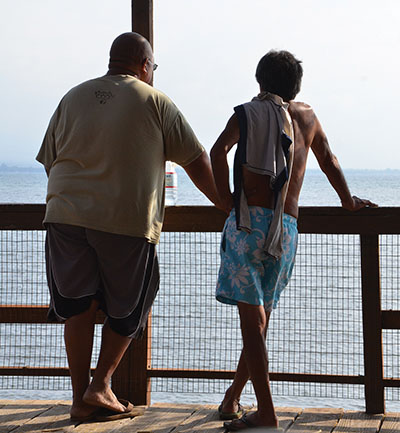
Among adventurers who risk everything, there comes a great respect, camaraderie, and humor. “In mannerisms, Shorty is very much like Mau,” Chadd laughs, “So we kid Shorty, and call him Yoda—just because of his wisdom is so deep. Shorty is a very special spirit—he’s no different than Mau; they are very much alike.”
Yet Chadd and Shorty are different. Chadd is a huge bear of a man with a big laugh and a heart of gold. Shorty is thoughtful, quiet, and well—Yoda—full of wisdom that comes from hard-earned experience.
Observing Shorty training some students, Chadd says, “In the last few years, Shorty has really come into his own and become quite a teacher for the crew and the students. It’s been really special to watch him and see what he’s doing.”
Chadd continues with one of the highest compliments, “He’s been there”—meaning, there is no substitute for real experience —“And it’s very exciting to watch him share his knowledge. Shorty is a very quiet man, and when he speaks—you want to be there.”
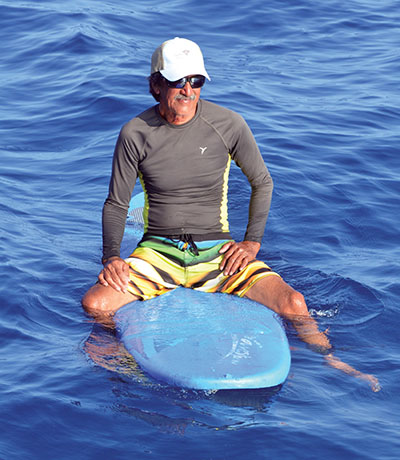
Mau’s other pupil, Nainoa Thompson, instructed Kalepa Baybayan in the art of wayfinding. From the tender age of 19, Kalepa had his sights set on the sails. In a 2000 interview with Sam Low, Kalepa is quoted as saying, “When I first saw Hōkūle’a in 1975, it just grabbed my heart. I knew that if there was anything in life that I wanted to do it was sail on her.”
Eight Hōkūle‘a voyages have since been led by Kalepa. He currently works as Navigator-in-Residence at ‘Imiloa Astronomy Center. It is through this work, Chadd says, Kalepa has “expanded the opportunity for people to experience voyaging…a great example of giving back to the communities that have given so much to our canoes.”
Just as his teachers before him, Kalepa is helping to perpetuate the knowledge and skills required to keep the wayfinding techniques of the kupuna alive.
The Vision
The Polynesian Voyaging Society says, “The mission of Hōkūle‘a’s Worldwide Voyage is to navigate toward a healthy and sustainable future for ourselves, our home—the Hawaiian Islands—and our Island Earth through voyaging and new ways of learning. Our core message is to mālama (care for) Island Earth—our natural environment, children, and all humankind.”

This will be accomplished with educational programs on all levels that will utilize sophisticated tracking and communications technology to monitor the canoes via the internet and allow students to interact and follow the exploits of the canoes and crew members. On Hawai‘i Island, the educational programs have begun with a corps of teachers assisted by Kumu Pua Case of Waimea along with teacher training in all of the schools to help them develop school programs. One goes on the Makali‘i and is trained in voyaging, navigation, resource management, and sustainability.
Chadd says, ”By using crew members who are on-island, we can send them into the classrooms to assist the teachers to teach those lessons.”
“We’ve taught a chant recently to all of the teachers called ‘Malana Mai.’ It’s a chant that connects all of our communities on the island. It was created by Queen Emma when she came to Hawai‘i Island. It’s about 200 lines long, but we only took the portion of it where she describes Hawai‘i Island like a canoe and the different districts as different parts of the canoe. By educating each one of these teachers who will be sharing it with their students, they understand that as an island whole—like the voyage—we are all connected.”
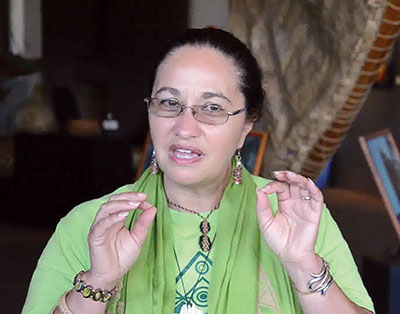
“Connecting our communities to the culture can sometimes be a challenge. The thing for our communities to understand is that our culture is a living lifestyle that does not have an on-off switch. It’s understanding that when you choose to live your culture as a lifestyle, that it’s in everything you do, it’s in every person that you interact with. And when we say “He wa‘a he moku, he moku he wa‘a” (the canoe is an island, the island is a canoe), it isn’t for a special event. You are your culture—Every day—every morning, every night. That is who you are.”
I told Chadd, “When Clay Bertelmann was captain, he taught me that Makali‘i is not really about sailing—it’s about living the old ways.”
Chadd laughed and said, ”Sailing is just the icing on the cake. Makali‘i has always been about who you are as a person—who you are going to be in your life. Some of those kids who sailed with us when you first started with us 10 or 12 years ago are teachers now. They are the ones teaching these chants to their kids.”
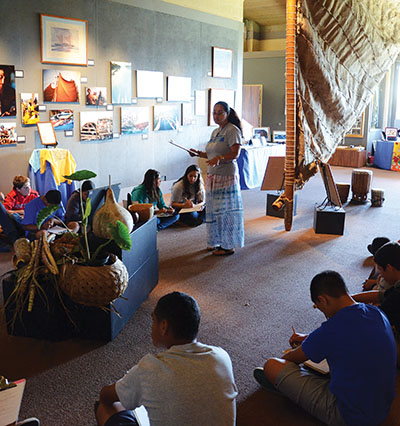
He continues, “I think this voyage for me—means that the possibility of my ancestors going far beyond the horizon, even outside of Polynesia, is possible. Because, if I think that we can do this, why wouldn’t my ancestors have thought the same?
”Because, I am them. For me, this voyage is about how great a people that I come from—that we understood our connection to our world. That the same ocean that touches our moku (island) touches another many miles away. The same winds that blow through our sails carry us far beyond our horizons. And that our only limitations are within our own mind. So this voyage is a reaffirmation that I come from a people without boundaries.”
A profound aspect of this journey, is that the canoes will travel the planet uniting with indigenous people around the globe sharing their mana‘o (knowledge) and creating a network of native knowledge and sharing this with the rest of the world to create awareness and a unique indigenous perspective of the global situation. They believe that ancient wisdom can and will inspire contemporary solutions.
Westerners might question the validity of an indigenous point of view and discount it due to western stereotypes of indigenous people being inferior in technology and sophistication, though many learned scholars have strongly disagree with those theories.
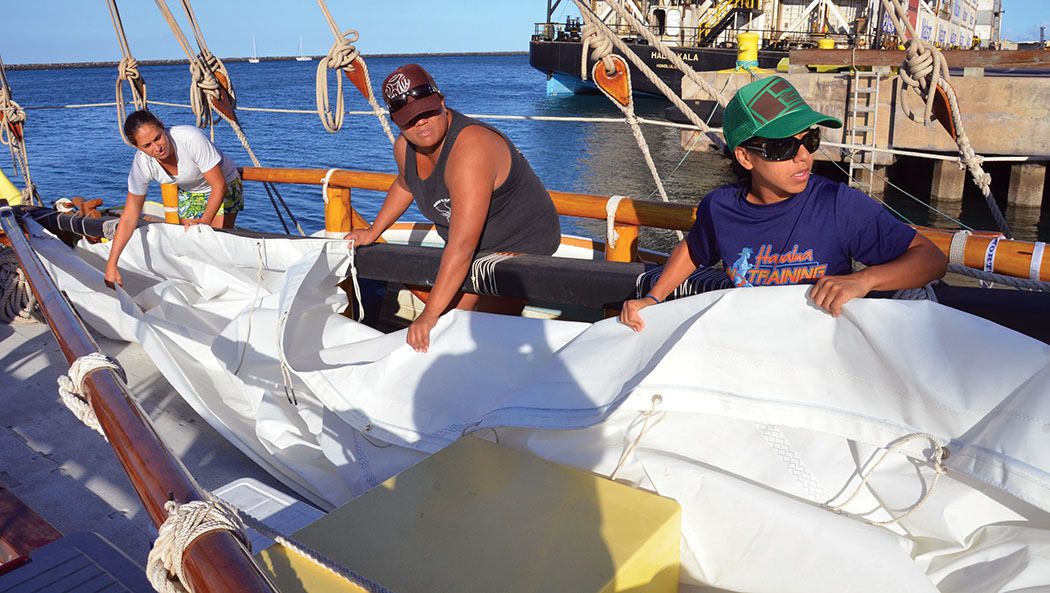
As an artist and historian, Herb Kāne, in his book, Voyagers, discusses the dichotomy of two civilizations where the western world was developing an audacity using technology to dominate the world, while the Polynesian world as an indigenous culture were developing a supernatural approach, becoming at one and more harmonious with nature and succeeding in a different way. Their development of lōkahi—of being in unity or balance or in a harmonious relationship with the natural and spiritual world—made them one of the healthiest and successful people on the planet. They were the finest sailors and explorers the world has ever known, exploring 10 million square miles of the Pacific Ocean and more than 100,000 islands. All this was accomplished more than 1,000 years before the European sailors ever left sight of their shore—and they did it without any navigational instruments.
Also in support of this ancient Hawaiian wisdom is Kenneth Brown, the great grandson of John Papa Īī, advisor to King Kamehameha IV, a successful businessman, architect, and a visionary who supported Hawaiian cultural growth. “To the Hawaiian, the universe he knew was coherent and harmonious. For the westerner, the further the science took him up into cosmic space, and down into micro physics, the less it served as an acceptable discipline for living.”
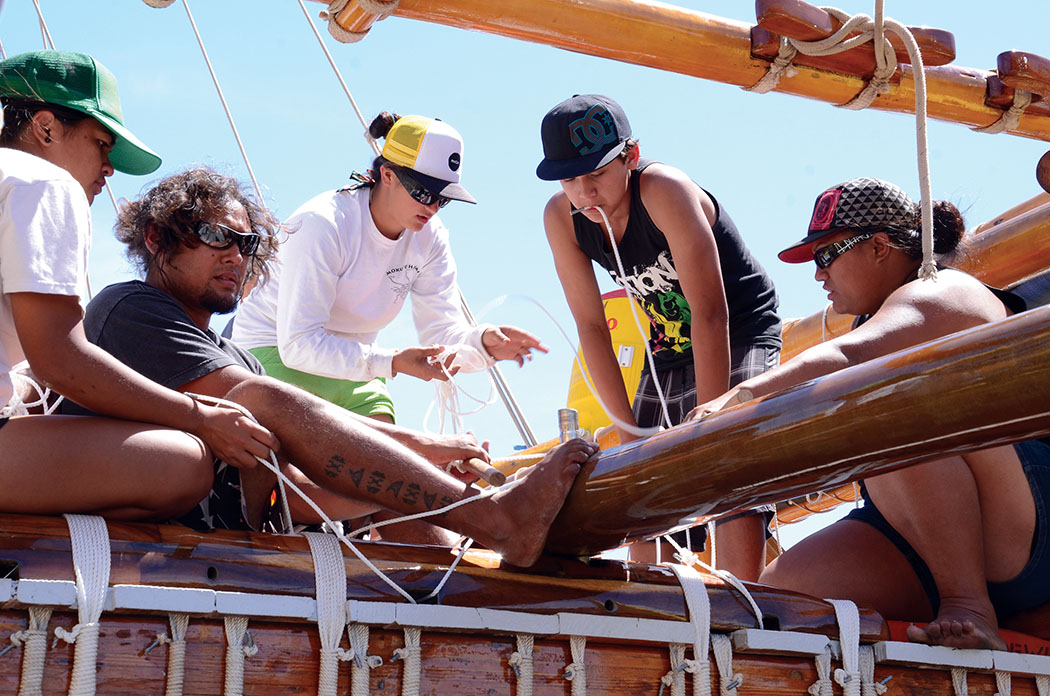
Dr. George Kanahele, the spiritual father of the Hawaiian renaissance, in his book Ku Kanaka offers, “We are a people with profound capacity for experiencing that which is extraordinary, sacred or kapu; a people with an abiding faith in the shared divinity—the mana—of man, nature and the cosmos beyond; a people able from the primal past to explain through myth, symbolism, and ritual transcendent realities of life; a people ‘in sync’ with the rhythms of the universe; a people who see time not as a linear measurement but is a qualitative experience: a people with an unsurpassed sense of place and the unity of all things.”
Hawaiians and other indigenous people have been tracking the declining situation on the earth for many decades and are rising up making their voices heard. Kumu Pua Case is a warrior on Hawai‘i Island who is answering the call by supporting the WWV as an educator and by adding her voice to take a stand for what is right.
“There is no coincidence here that at the beginning of this year, globally there is a shift in the air; by our relations in Canada, in Mexico, in Aotearoa, in Peru—they are idle no more—they are saying enough is enough. I am hopeful that it is grounded in peace and it is grounded in compassion and grounded in what is right for the earth and sky and for all of us in balance and harmony and justice. That it is just about what is pono, what is right, what should be. “The awakening is taking place around the planet.”
Reflecting on the people of Hawai‘i Island, Pua says, “Our young people in their classrooms are going to get to know what it’s like to live on the other side of the world—something they never would have been exposed to or would have experienced. That’s going to be available to them.”

When I asked Chadd what his dream for this island was he said, “For our makua (parents), ask your kids what they know about this voyage. Then allow the conversation to happen. Engage with them in a way that will have them ask questions. It’s important that we have our community, our makua, our kumu (teachers), and schools talk with our young people so they understand it is important for them to be involved on this island, with the community, and with their family. Simple things are the most important. We need to constantly challenge ourselves to be better each day. We can do great things—and our youth need to understand that. They need us to be those examples, and if we can do that, their future is going to be great.”
Excited for the possibilities, Pua added, “What I hope for everyone is—don’t miss out! Don’t miss out on the opportunity to be a part of this voyage in any way your heart says—I must be a part of the voyage. Don’t miss the boat! Get on board—be a part of it, because it will change you, even if it’s a small change. At the end of the voyage you will be a bigger, deeper, transformed person if you just get on board. Just get on board.” ❖
For more information:
Worldwide Voyage: Nakalaiwaa.org, @HokuleaWWV on Twitter
Polynesian Voyaging Society: 808.842.1101, hokulea.org
Makali‘i/Na Kalai Wa‘a: 808.885.9500, facebook.com/waamakalii
Contact writer and photographer Keith Nealy: KeithNealy.com
